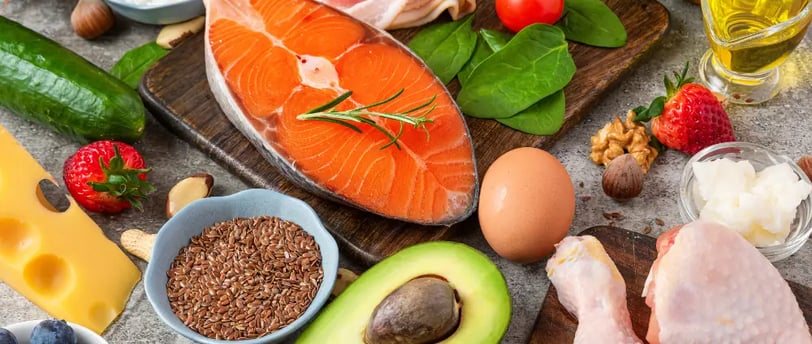
Unlocking Nutrition Secrets for a Balanced Weekly Meal Plan
Explore the key nutrition basics for crafting a balanced weekly menu that supports health, energy, and overall well-being.Blog post description.
MEAL PREP PLANNING
Mae Ellison
2/27/20254 min read


What Are Nutrition Basics for a Balanced Weekly Menu?
In today’s fast-paced world, maintaining a healthy and balanced diet can often feel like a challenge. Between busy schedules and the temptation of quick, processed foods, it’s easy to overlook the importance of proper nutrition. However, with a little planning and knowledge, creating a balanced weekly menu is not only achievable but also incredibly rewarding for your overall health.
A well-balanced diet is about more than just eating the right foods—it’s about incorporating a variety of nutrients into your meals to fuel your body properly and keep you energized throughout the day. Whether you're looking to improve your health, manage weight, or simply feel better overall, meal planning is a powerful tool that can help you reach your goals.
In this post, we’ll break down the basics of nutrition and provide you with the essentials to build a balanced weekly menu. From understanding macronutrients and micronutrients to creating simple, delicious meals, you’ll learn everything you need to know to start planning healthier, more satisfying meals for the week ahead.
The Foundation of a Balanced Diet
Building a balanced weekly menu starts with understanding the essential components of a healthy diet. At the core of every meal plan are macronutrients, micronutrients, and fiber. These play an important role in ensuring your body gets the fuel and nourishment it needs to stay healthy.
Macronutrients & Micronutrients
Macronutrients are the nutrients your body needs in larger amounts, including proteins, carbohydrates, and fats. Micronutrients, on the other hand, are vitamins and minerals required in smaller amounts but are equally crucial for maintaining health.
Proteins help build and repair tissues, and they are essential for immune function. Great sources include lean meats like chicken, turkey, fish, and plant-based options like tofu and legumes.
Carbohydrates are the body’s main source of energy. They are found in whole grains like quinoa, oats, brown rice, and fruits and vegetables.
Healthy Fats are important for brain health, hormone production, and cell function. Sources of healthy fats include avocados, olive oil, nuts, seeds, and fatty fish like salmon.
Micronutrients like vitamins and minerals support various bodily functions such as bone health, immune support, and the production of red blood cells. Foods rich in micronutrients include leafy greens, citrus fruits, dairy products, and fortified foods.
Whole vs. Processed Foods
When building a weekly menu, it’s essential to prioritize whole foods over processed ones. Whole foods like fresh fruits, vegetables, lean meats, and whole grains are nutrient-dense and provide the body with essential vitamins, minerals, and fiber. On the other hand, processed foods—often high in sugar, unhealthy fats, and artificial additives—lack these nutrients and contribute to various health problems.
For example, choose whole fruits instead of sugary juices, or opt for whole wheat bread over white bread. The more you focus on unprocessed, whole foods, the better your diet will be for overall health.
How to Create a Balanced Weekly Menu
Planning a balanced weekly menu is all about ensuring variety, proper food groups, and meal preparation. By including a mix of food groups and following simple planning strategies, you can create meals that are nutritious and satisfying.
Incorporating Food Groups
A balanced meal should contain all the essential food groups. Here’s a breakdown:
Vegetables & Fruits: These should form the foundation of your meals, providing fiber, vitamins, and minerals. Aim for a variety of colors to ensure you’re getting a wide range of nutrients.
Grains: Choose whole grains like brown rice, quinoa, and whole wheat pasta, which are rich in fiber and help maintain steady energy levels.
Protein: Include lean proteins such as chicken, fish, tofu, and legumes to support muscle growth and repair.
Dairy or Alternatives: If you consume dairy, include options like low-fat yogurt, cheese, and milk. If not, consider plant-based alternatives like almond milk or fortified soy products.
Including a variety of foods from all these categories ensures a well-rounded and nutrient-dense meal plan.
Variety and Color
Variety is key to a balanced diet. Eating a wide range of foods ensures you get all the nutrients your body needs, while also preventing boredom with your meals. A colorful plate, filled with a variety of fruits and vegetables, often indicates a healthy, nutrient-rich meal.
Red, Orange, Yellow: These colors are often high in vitamins A and C, essential for skin health and immunity.
Green: Leafy greens like spinach, kale, and broccoli are rich in iron, calcium, and fiber.
Purple and Blue: These are packed with antioxidants, which help protect cells from damage and support heart health.
By aiming for a rainbow of colors on your plate, you can be sure you’re getting a range of nutrients that promote overall health.
Essential Nutrient-Dense Foods for Every Menu
To ensure your weekly menu is as nutrient-dense as possible, you’ll want to focus on including whole, nutrient-packed foods in your diet. These foods provide essential vitamins, minerals, and healthy fats to support your body’s daily functions.
Lean Proteins and Plant-Based Proteins
Proteins are essential for muscle repair, immune function, and overall health. Including both animal-based proteins (chicken, turkey, eggs) and plant-based proteins (tofu, lentils, beans) provides variety and ensures you get a full spectrum of amino acids.
Healthy Fats
Incorporating healthy fats into your meals is essential for brain function, heart health, and hormone production. Good sources of healthy fats include:
Avocados
Olive oil
Nuts (almonds, walnuts)
Seeds (chia, flax)
Fatty fish (salmon, sardines)
These fats are essential for cell function and help you absorb fat-soluble vitamins like A, D, E, and K.
Whole Grains and Fiber
Fiber is critical for digestion and gut health. It also helps regulate blood sugar and cholesterol levels. Great sources of fiber include whole grains like quinoa, brown rice, and oats, as well as fiber-rich vegetables and fruits.
Conclusion
Building a balanced weekly menu is a rewarding way to improve your overall health and well-being. By incorporating a variety of macronutrients (proteins, carbs, fats), micronutrients (vitamins and minerals), and fiber into your meals, you’ll create a diet that nourishes your body and supports long-term health.
Remember, small changes lead to big results! Start by planning one balanced meal at a time, and gradually increase the variety and nutrient-dense options in your diet. With the tips in this post, you’ll be well on your way to creating a weekly menu that fuels your body, boosts your energy, and improves your quality of life.
